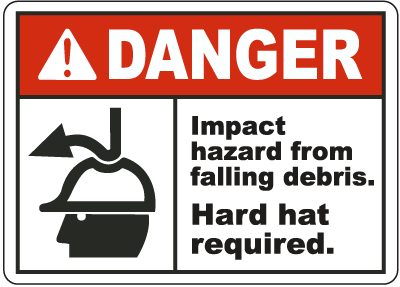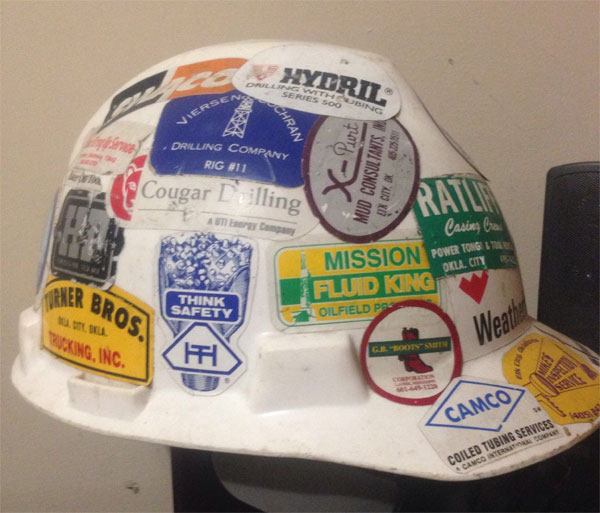
Hard hats must be worn when working in areas where there is a potential for injury to the head from falling objects.
Wearing a hard hat is one of the easiest ways to protect the most important part of your body - the head. A head injury can kill you or even impair you for life. Hard hats can protect you from impact and penetration hazards as well as from electrical shock and burn hazards.
To comply with OSHA regulations for head protection, a hard hat must be worn "when working in areas where there is a potential for injury to the head from falling objects." These regulations are referenced in 29 Code of Federal Regulations (CFR) 1910.135 and 1926.100.
The standard also covers conditions where electrical hazards are present. According to 1910.135(a)(2), "Protective helmets designed to reduce electrical shock hazard shall be worn by each such affected employee when near exposed electrical conductors which could contact the head."
Different kinds of tasks and situations call for different types of hard hat, so it's important to know the difference between the ANSI-defined classes and available designs.
ANSI Z89.1 - Requirements for Industrial Head Protection
Versions of ANSI Z 89.1 prior to 1997 only used Type 1 and Type 2 classifications to distinguish between caps and full brimmed hats. These classifications are now used to describe the protection characteristics of each hard hat.
- Type I helmets offer protection from blows to the top of the head.
- Type II helmets offer protection from blows to both the top and sides of the head.
The 1997 revision of Z89.1 also re-designated the electrical-protective classifications for helmets:
- Class G hard hats are designed to reduce the danger of contact with low-voltage conductors and are proof tested at 2,200 volts
- Class E hard hats are designed to reduce the danger of contact with conductors at higher voltage levels and are proof tested at 20,000 volts
- Class C hard hats are not designed to provide protection against contact with electrical hazards.
Another class of protective headgear on the market called "bump hat's" are designed to protect from head bumps or lacerations in areas with low head clearance. These hats are not designed to protect against falling or flying objects and are not ANSI approved.
Performance tests for hard hats
Significant changes in the Z89.1 standard came in January 2009 that added three non-mandatory performance tests for hard hats:
 Reverse donning: Hard hats marked with a "reverse donning arrow" can be worn frontward or backward in accordance with the manufacturer's wearing instructions. They pass all hard hat testing requirements, whether worn frontward or backward.
Reverse donning: Hard hats marked with a "reverse donning arrow" can be worn frontward or backward in accordance with the manufacturer's wearing instructions. They pass all hard hat testing requirements, whether worn frontward or backward.- Lower temperature: Hard hats marked with an "LT" indicate that the hard hat meets all testing requirements of the standard when preconditioned at a temperature of -30°C (-22°F).
- High visibility: Hard hats marked "HV" indicate that the hard hat meets all testing requirements of the standard for high visibility colors. This includes tests for chromaticity and luminescence.
Hard hat marking requirements
More changes to the ANSI Z89.1 standard came in 2014, with the most notable being hard hat marking requirements. The following information must be marked on the inside of each helmet:
- The manufacturer's name or identifying mark
- Date of Manufacture
- The legend, "ANSI Z89.1-2014"
- The Type and Class Designation
- The approximate head size range
If optional performance features are applicable, the appropriate marking(s) below must be applied in the sequence as shown:
- Reverse Donning
- Lower Temperature (LT)
- Higher Temperature (HT)
- High Visibility (HV)
Proper Care of Hard Hats
All hard hat components and accessories should be inspected daily for signs of dents, cracks, penetration and any damage due to impact, rough treatment or wear that might reduce the degree of protection originally provided.
Avoid prolonged exposure to UV radiation. In addition to everyday wear and tear, ultraviolet (UV) radiation can pose a problem for hard hats constructed of plastic materials. If the hat loses its glossy finish or has a chalky appearance it should be removed from service.

Painting or putting stickers on a hard hat is acceptable by OSHA if authorized by the manufacturer or if the employer can demonstrate the reliability of the helmet is not affected by the alteration.
Always replace a hard hat if it sustains an impact, even if damage is not noticeable. Suspension systems are offered as replacement parts and should be replaced when damaged or when excessive wear is noticed. It is not necessary to replace the entire hard hat when deterioration or tears of the suspension systems are noticed.
OSHA Approved Hard Hat Stickers
Painting or putting stickers on a hard hat is acceptable by OSHA if authorized by the manufacturer or if the employer can demonstrate the reliability of the helmet is not affected by the alteration. The paint or stickers should not reduce the ability to identify defects (i.e., use of see-through stickers) or other conditions that would indicate a reduced reliability.
How long can a hard hat be used?
It is a common misconception is that hard hats have a predetermined service life. Specific service life, defined in terms of number of years, is not required though individual manufacturers may choose to include such information for their helmets.
Can a cap, scarf, liner or other items be worn under a hard hat?
OSHA recommends that employers permit only liners that are specifically designed to be compatible with the protective properties of the hard hat. Contact the hard hat manufacturer to determine if the liner or garment is compatible with the use of the hard hat.
